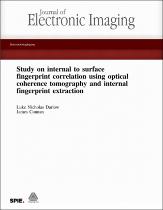 ResearchSpace
ResearchSpace
Study on internal to surface fingerprint correlation using optical coherence tomography and internal fingerprint extraction
JavaScript is disabled for your browser. Some features of this site may not work without it.
- ResearchSpace
- →
- Research Publications/Outputs
- →
- Journal Articles
- →
- View Item
| dc.contributor.author |
Darlow, LN

|
|
| dc.contributor.author |
Connan, J

|
|
| dc.date.accessioned | 2016-07-20T11:00:11Z | |
| dc.date.available | 2016-07-20T11:00:11Z | |
| dc.date.issued | 2015-11 | |
| dc.identifier.citation | Darlow, L.N. and Connan, J. 2015. Study on internal to surface fingerprint correlation using optical coherence tomography and internal fingerprint extraction. Journal of Electronic Imaging, 24(6), 063014(1)-063014(11) | en_US |
| dc.identifier.issn | 1017-9909 | |
| dc.identifier.uri | http://electronicimaging.spiedigitallibrary.org/article.aspx?articleid=2476122 | |
| dc.identifier.uri | http://hdl.handle.net/10204/8651 | |
| dc.description | Copyright: 2015 SPIE | en_US |
| dc.description.abstract | Surface fingerprint scanners are limited to a two-dimensional representation of the fingerprint topography, and thus, are vulnerable to fingerprint damage, distortion, and counterfeiting. Optical coherence tomography (OCT) scanners are able to image (in three dimensions) the internal structure of the fingertip skin. Techniques for obtaining the internal fingerprint from OCT scans have since been developed. This research presents an internal fingerprint extraction algorithm designed to extract high-quality internal fingerprints from touchless OCT fingertip scans. Furthermore, it serves as a correlation study between surface and internal fingerprints. Provided the scanned region contains sufficient fingerprint information, correlation to the surface topography is shown to be good (74% have true matches). The cross-correlation of internal fingerprints (96% have true matches) is substantial that internal fingerprints can constitute a fingerprint database. The internal fingerprints’ performance was also compared to the performance of cropped surface counterparts, to eliminate bias owing to information level present, showing that the internal fingerprints’ performance is superior 63.6% of the time. | en_US |
| dc.language.iso | en | en_US |
| dc.publisher | SPIE | en_US |
| dc.relation.ispartofseries | Workflow;16170 | |
| dc.subject | Surface fingerprint scanners | en_US |
| dc.subject | Fingerprint topography | en_US |
| dc.subject | Optical coherence tomography | en_US |
| dc.subject | OCT | en_US |
| dc.subject | Internal fingerprints | en_US |
| dc.title | Study on internal to surface fingerprint correlation using optical coherence tomography and internal fingerprint extraction | en_US |
| dc.type | Article | en_US |
| dc.identifier.apacitation | Darlow, L., & Connan, J. (2015). Study on internal to surface fingerprint correlation using optical coherence tomography and internal fingerprint extraction. http://hdl.handle.net/10204/8651 | en_ZA |
| dc.identifier.chicagocitation | Darlow, LN, and J Connan "Study on internal to surface fingerprint correlation using optical coherence tomography and internal fingerprint extraction." (2015) http://hdl.handle.net/10204/8651 | en_ZA |
| dc.identifier.vancouvercitation | Darlow L, Connan J. Study on internal to surface fingerprint correlation using optical coherence tomography and internal fingerprint extraction. 2015; http://hdl.handle.net/10204/8651. | en_ZA |
| dc.identifier.ris | TY - Article AU - Darlow, LN AU - Connan, J AB - Surface fingerprint scanners are limited to a two-dimensional representation of the fingerprint topography, and thus, are vulnerable to fingerprint damage, distortion, and counterfeiting. Optical coherence tomography (OCT) scanners are able to image (in three dimensions) the internal structure of the fingertip skin. Techniques for obtaining the internal fingerprint from OCT scans have since been developed. This research presents an internal fingerprint extraction algorithm designed to extract high-quality internal fingerprints from touchless OCT fingertip scans. Furthermore, it serves as a correlation study between surface and internal fingerprints. Provided the scanned region contains sufficient fingerprint information, correlation to the surface topography is shown to be good (74% have true matches). The cross-correlation of internal fingerprints (96% have true matches) is substantial that internal fingerprints can constitute a fingerprint database. The internal fingerprints’ performance was also compared to the performance of cropped surface counterparts, to eliminate bias owing to information level present, showing that the internal fingerprints’ performance is superior 63.6% of the time. DA - 2015-11 DB - ResearchSpace DP - CSIR KW - Surface fingerprint scanners KW - Fingerprint topography KW - Optical coherence tomography KW - OCT KW - Internal fingerprints LK - https://researchspace.csir.co.za PY - 2015 SM - 1017-9909 T1 - Study on internal to surface fingerprint correlation using optical coherence tomography and internal fingerprint extraction TI - Study on internal to surface fingerprint correlation using optical coherence tomography and internal fingerprint extraction UR - http://hdl.handle.net/10204/8651 ER - | en_ZA |







